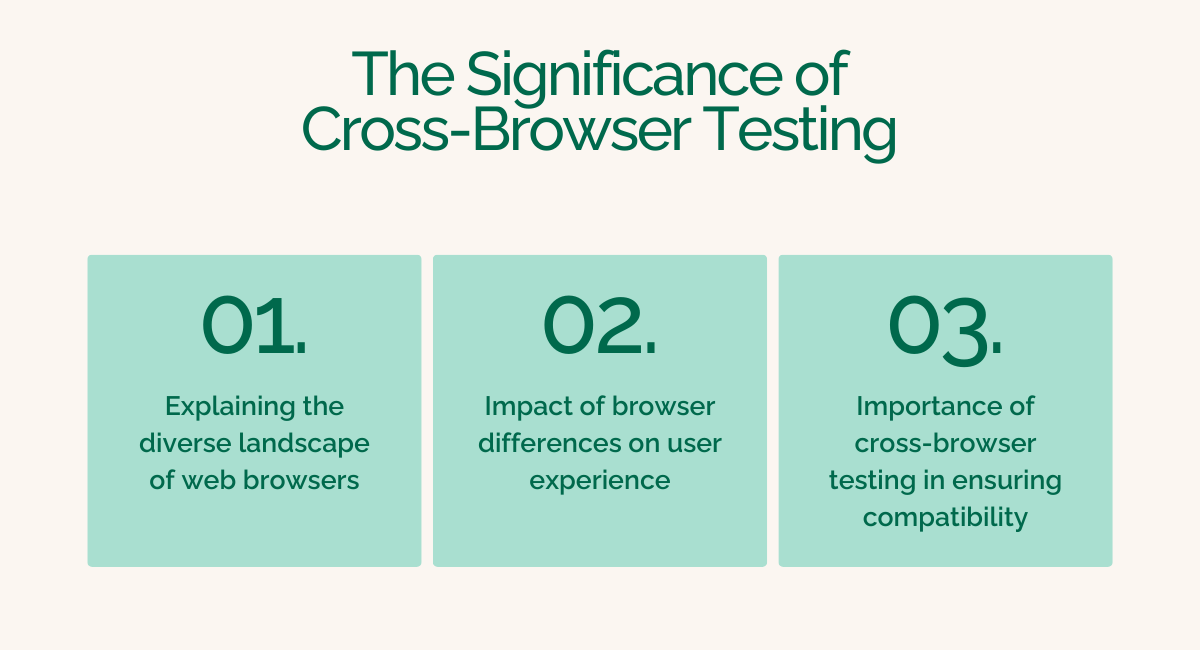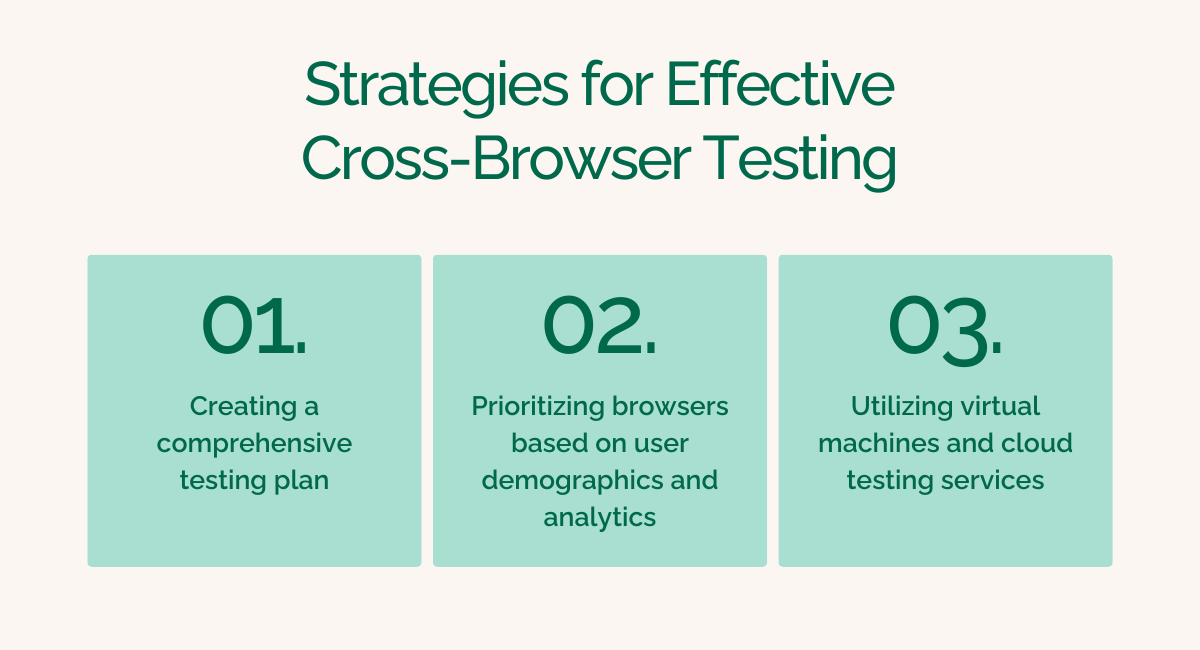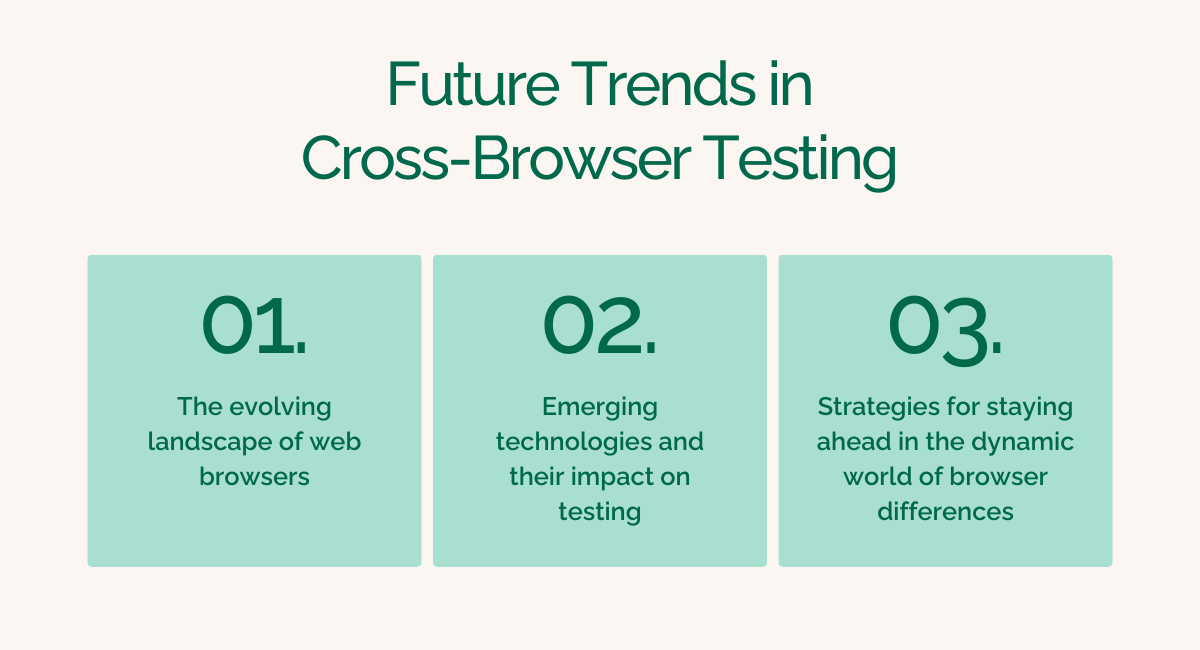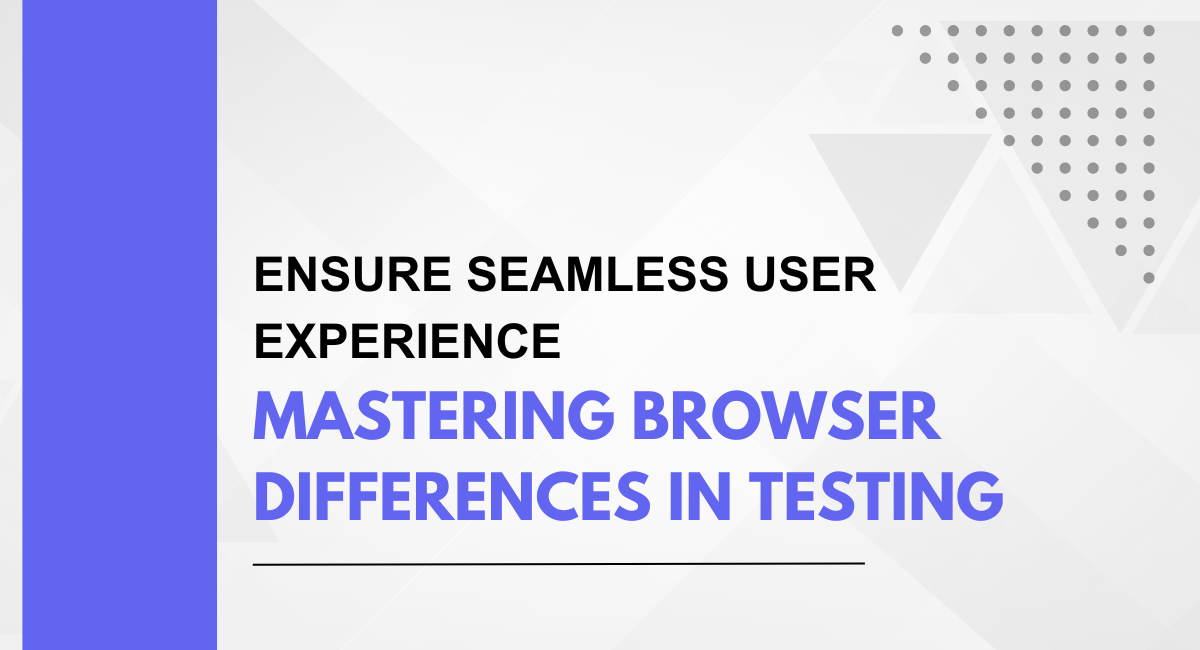One of the major hurdles in delivering a consistent user experience lies in the diversity of web browsers. Users access websites and applications using a variety of browsers such as Chrome, Firefox, Safari, Edge, and more as Cross-Browser Testing. Each browser interprets and renders code differently, leading to potential discrepancies in how a website functions.
Additionally, different browser versions and the ever-changing landscape of web standards introduce complexities in ensuring compatibility. The challenges don't stop there. Mobile devices further compound the testing matrix, as users access content on smartphones and tablets with varying screen sizes and resolutions. Responsive design is crucial, but testing its effectiveness across different browsers and devices adds an extra layer of complexity.
The Significance of Cross-Browser Testing

A. Explaining the diverse landscape of web browsers
The web ecosystem is characterized by a diverse array of web browsers, each with its own rendering engine, standards support, and quirks. Popular browsers such as Chrome, Firefox, Safari, and Edge compete for user attention, and each has a significant market share.
This diversity extends to the various versions of these browsers, with users often running different iterations based on their preferences or system constraints. Understanding this diverse landscape is crucial for developers seeking to deliver a consistent experience to users across platforms.
B. Impact of browser differences on user experience
Browser differences can have a profound impact on the user experience of a website or application. The way browsers interpret and execute code varies, leading to inconsistencies in how web pages are displayed and how features function. Elements that work seamlessly in one browser might encounter issues or exhibit different behavior in another. These discrepancies can range from minor layout differences to critical functionality failures, affecting user engagement and satisfaction.
Moreover, the performance of a website can vary significantly between browsers. Load times, responsiveness, and overall user perception may differ, influencing user trust and retention. In a competitive digital landscape, users are quick to abandon sites that do not meet their expectations, making it imperative for developers to address and mitigate the impact of browser differences on the overall user experience.
C. Importance of cross-browser testing in ensuring compatibility
Cross-browser testing is the proactive approach to mitigate the challenges posed by browser differences. It involves testing a website or application across various browsers and their different versions to ensure consistent performance and functionality. By conducting thorough cross-browser testing, developers can identify and address compatibility issues early in the development process, reducing the risk of users encountering problems in the live environment.
Ensuring compatibility through cross-browser testing not only enhances the user experience but also contributes to a website's accessibility. It allows developers to cater to a broader audience, considering users who may have different preferences or constraints when it comes to their choice of browsers. Furthermore, cross-browser testing aligns with best practices in web development and contributes to a positive brand image by demonstrating a commitment to quality and user satisfaction.
Strategies for Effective Cross-Browser Testing

A. Creating a comprehensive testing plan
A comprehensive testing plan is the foundation of successful cross-browser testing. This plan should outline the browsers, browser versions, and devices that are relevant to the target audience. Consider factors such as geographic location, demographics, and user behavior to prioritize testing scenarios.
The testing plan should cover various aspects, including functional testing, performance testing, and visual testing. By having a well-defined plan, developers and QA teams can systematically approach testing and ensure thorough coverage across different browser environments.
B. Prioritizing browsers based on user demographics and analytics
Not all browsers are created equal, and user preferences can vary based on factors such as geography, device type, and demographic characteristics. Analyzing website analytics can provide valuable insights into the browsers and devices used by the majority of your audience.
Prioritize testing on browsers with the highest market share and those commonly used by your target demographic. This data-driven approach allows for a more efficient allocation of testing resources, focusing efforts where they are most impactful in delivering a positive user experience.
C. Utilizing virtual machines and cloud testing services
Testing across multiple browsers and devices can be resource-intensive, but virtual machines and cloud testing services offer scalable solutions. Virtual machines enable testing on different operating systems and browser configurations without the need for physical devices.
Cloud testing services, such as BrowserStack or Sauce Labs, provide a platform for testing on a wide range of browsers and devices in a virtual environment. These services enable parallel testing, saving time and resources while ensuring broad coverage. Integrating virtual machines and cloud testing into the testing workflow enhances flexibility and allows for comprehensive cross-browser testing.
Book a Demo and experience ContextQA testing tool in action with a complimentary, no-obligation session tailored to your business needs.
Future Trends in Cross-Browser Testing

A. The evolving landscape of web browsers
The web browser landscape is in a perpetual state of evolution, with new browsers entering the scene and existing ones continuously updating. Keeping abreast of these changes is crucial for effective cross-browser testing. Some key trends in the evolving browser landscape include:
- New Browser Entrants: Keep an eye on emerging browsers that gain popularity. User preferences may shift, leading to changes in the dominant browsers used by your audience.
- Browser Version Updates: Browser vendors regularly release updates to improve performance, security, and standards compliance. Staying informed about these updates is essential for maintaining compatibility.
- Cross-Device Browsing: With the proliferation of various devices, including smartphones, tablets, and wearables, cross-device testing will become increasingly important. Browsers will need to adapt to different form factors and input methods.
B. Emerging technologies and their impact on testing
Advancements in technology are driving changes in how we access and interact with the web. These emerging technologies have implications for cross-browser testing:
- Progressive Web Apps (PWAs): PWAs are becoming more prevalent, offering a seamless user experience across devices. Testing strategies need to adapt to ensure compatibility and functionality across both traditional browsers and PWA-enabled environments.
- Voice-Activated Browsing: As voice-activated interfaces gain popularity, testing for voice interactions and commands will become essential. Browsers may evolve to better support these interfaces, requiring corresponding updates to testing approaches.
- WebAssembly (Wasm): The adoption of WebAssembly for performance-intensive tasks may impact how browsers render and execute code. Testing frameworks will need to accommodate these changes to ensure accurate and reliable testing results.
C. Strategies for staying ahead in the dynamic world of browser differences
To stay ahead in the dynamic world of browser differences, consider the following strategies:
- Continuous Learning and Adaptation: Stay informed about emerging browser trends, technologies, and testing methodologies. Continuous learning is key to adapting to the evolving web landscape.
- Collaboration with Browser Vendors: Engage with browser vendors and participate in beta testing programs. This collaboration provides insights into upcoming changes and ensures early testing compatibility.
- Automation and AI Integration: Embrace automation and explore the integration of artificial intelligence (AI) in testing. Automated testing tools that leverage AI can enhance test coverage and efficiency in identifying browser compatibility issues.
- Scalable Testing Infrastructure: Ensure that your testing infrastructure is scalable to accommodate new browsers and versions. Utilize cloud-based testing services that offer flexibility and scalability in testing across a diverse range of environments.
- User-Centric Testing: Prioritize testing based on user demographics and behavior. Understanding how your users interact with your application across different browsers and devices is essential for effective testing.
By anticipating and adapting to these future trends, developers and QA professionals can position themselves to navigate the evolving landscape of browser differences successfully. Embracing a forward-thinking approach to cross-browser testing ensures that your web applications remain resilient, compatible, and user-friendly in the face of technological advancements.
Seamless User Experience
Ultimately, the success of any web development project hinges on the user experience it delivers. Encouragement is extended to prioritize user experience through comprehensive cross-browser testing. By understanding user demographics, creating targeted testing plans, and utilizing the right testing tools, developers can confidently navigate the diverse browser landscape.
The investment in effective cross-browser testing not only ensures compatibility but also contributes to building a positive brand image and fostering user trust and loyalty.
You may also be interested in: Build Trust & Confidence: Comprehensive Strategies for Secure, Reliable APIs
We make it easy to get started with the ContextQA tool: Start Free Trial.
